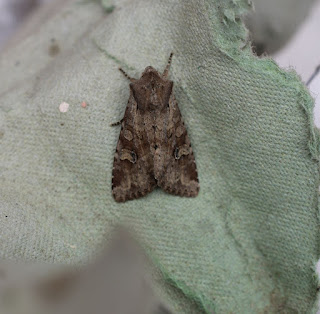 |
| Flame Shoulder (Ochropleura plecta) |
Since the beginning of April the gardens at Shandy Hall have been victims of the weather. Rain, hail, sleet, snow and very hard frosts have made attempts at moth trapping a thankless task. On the very few occasions the trap has been set, the result has been 'nothing to record'. Surely this can't have been the same for the county - or even the country? Laying out the white sheet, plugging in the mercury vapour lamp, making sure that collecting tubes are to hand along with a couple of small paint-brushes (in case some gentle coaxing is needed) and then finding the result is but only three moths can be discouraging.
The Flame Shoulder is a successful species and is resident and commonly found throught the UK. In Yorkshire there are two generations and the larvae find food sources in gardens, farmland, grassland, hedgerows and wetlands. The scientific name refers to the pale streak or 'twisted rope' (plecta) that is visible on the wing.

Swallow Prominent (Pheosia tremula)
There is a Swallow Prominent (Pheosia tremula) and a Lesser Swallow Prominent (Pheosia gnoma). They are easier to identify when one is compared directly against the other. The white, wedge-like marking is cleaner on the Swallow Prominent's wing. Leaves on the Silver Birch will sustain the caterpillar and the pupa overwinters underground. Pheosia means 'prickly plant' or 'spine' and tremula (shaking or trembling is also the scientific name of the aspen - 'willows whiten, aspens quiver' from Tennyson's The Lady of Shalott. Once this moth enters the trap it remains emphatically motionless until it is time to fly in the early evening.

Rustic Shoulder Knot (Apamea sordens)
Oh, the problems of the brown moths. Looking over the previous photographs in this blog and pondering the possibilities in an attempt to identify this moth accurately, I am left with the Rustic Shoulder Knot (Apamea sordens) as the most likely candidate. The three little dots on the leading edge of the wing and the shape and positioning of the kidney mark seem strong indicators, but I confess this is by no means certain. No doubt, should I be wrong, the error will be pointed out and an adjustment made.
Little hope for the weekend - more rain forecast - but an attempt will be made if possible.
